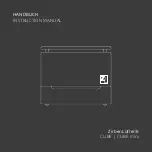
2.
3.
4.
5.
6.
7.
8.
9.
10.
11.
c.
Shielded RTD sensor with the shield terminated to the Series 1500 case
and to an existing ground plane.
Physical separation and wire routingmust be given careful consideration
in
planning
the
layout of the system.. For example, A.C. power supply lines
should be bundled together and physically kept separate from input signal lines
(very low power level). Keep all switched output signal lines (high power level)
separate from current control loop signals (low power level).
Excessive lead length in a two-wire RTD sensor can create indication errors.
For every 10 feet of lead length, a 1 ° C error is typical. To combat this, use a
three wire sensor in long lead applications.
Another important practice is to look at the system layout and identify electrical
noise sources such as solenoids, relay contacts, motors, etc, and where they
are physically located. Then route the wire bundles and cables as far away as
possible from these noise sources.
Shielded cables should be used for all low power signal lines to protect against
magnetic and electrostatic coupling of noise. Some simple pointers are as
follows:
l
Whenever possible, low level signal lines should be run unbroken from
signal source to the control circuit.
l
Connect the shield to the control circuit common end only. Never
leave the shield unconnected at both ends.
Never connect
both shield
.
ends to a common.
l
If the shield is broken at some termination point and then continued
on, the shield must be connected to maintain shield continuity.
l
If the shield is
used as a signal return, no electrostatic shielding
should
be assumed. If this must be done, use a triaxed cable (electrostatically
shielded coaxial cable).
Shielded twisted wire
be used anytime control circuit signals must travel
over two feet or when they are bundled in parallel with other signal wires (not
line voltage or load wires).
The size or gauge of wire should be selected by calculating the maximum circuit
current and choosing the guage meeting that requirement. Using greatly
larger wire sizes than
ed generally will increase the likelihood of
electrostatic (capacitance) coupling of noise.
Ground loops must be eliminated in the entire control system. There are obvious
loops which can be s
are also the not-so-o
potted by studying the “as-built" wiring diagram. There
bvious ground loops that result from techniques
connecting internal circuit commons in the manufacturers equipment. An
example of this would be if
if a control circuit is designed to work with a
grounded sensor input.
Do not daisy chain A.C. power (or return) lines or output signal (or return) lines to
multiple control circuits. Use a direct line from the power source to each input
requiring A.C. power. Avoid paralleling Ll (power lead) and L2 (return lead) to
bad power solenoids. Contactors, and control circuits. If
Ll
(power lead) is
used
to switch a load, (return lead) will have the same switched signal and
could couple unwanted noise into a control circuit.
Grounding the chassis of each piece of equipment in the system is very
important. The simple practice of connecting each individual chassis to the
overall equipment chassis immediately adjacent to that piece and then tying all
the major chassis
ground terminals to ether with one lead (usually green wire)
to ground at one signle point will
work
best.
Do
not
confuse chassis grounds (safety ground) with control circuit commons or
with A.C.
supply
lines
(return or neutral line). Each return system wiring
must be kept separate, making absolutely sure chassis ground (Safety) is
never
used as a conductor to return circuit current.
28
WATLOW Series 1500 User's Manual
Installation - Wiring,
Chapter 3
















































